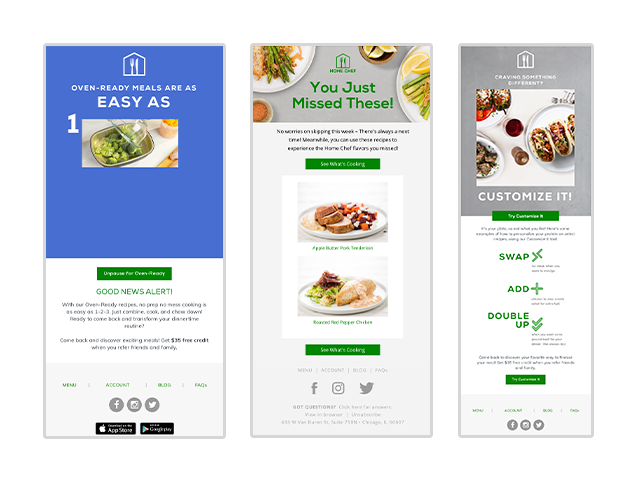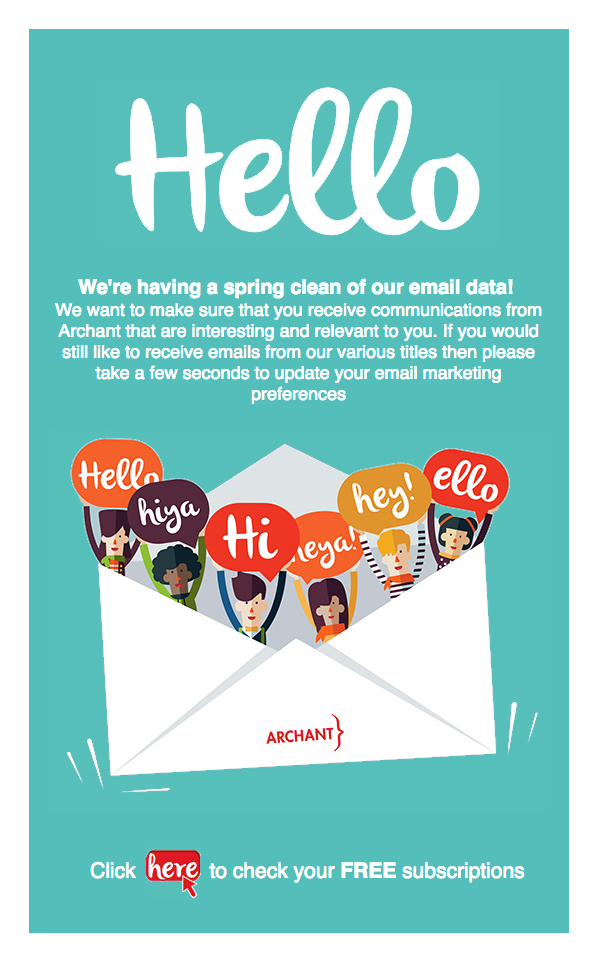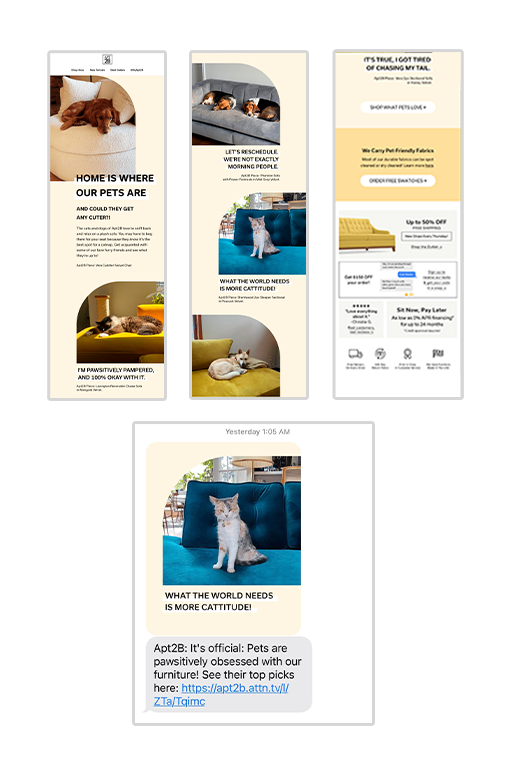It’s exciting for brands to get new customers. The customers get to experience your product for the first time and you can start to build a—hopefully—long-lasting relationship. Plus, as we all know, it’s more expensive to acquire a new customer than to retain an existing one. So, once you’re over the hurdle of acquisition, it’s all smooth sailing, right?
Sigh, that would be nice, wouldn’t it? But, the nurturing never stops.Customer relationships aren’t something you can “set and forget,” they take work. For example, if a customer, who has been loyal in the past but hasn’t made a purchase in a while, you, as a marketer, can’t just say “well, it was fun while it lasted.” Retaining customers, especially loyal ones, is too valuable! So, how do you go about getting back in the good graces of your dis-engaged customers? Create a campaign type that 63% of marketers deemed as “very effective:” the re-engagement campaign.
In our latest ebook, “Orchestrate Your Cross-Channel Campaigns for Peak Harmonization,” we touch upon a variety of marketing campaigns, including re-engagement campaigns, and detail what’s required for each and some tips for building them out. This article—the fourth and final in our series—will provide context around, and examples of, re-engagement campaigns.
What Are Re-Engagement Campaigns?
Re-engagement campaigns are often deployed when a customer is on the cusp of churning. They are still opted into your marketing communications but haven’t engaged with your content or made a purchase in a while. Re-engagement campaigns, in addition to being bolstered with special offers, should demonstrate your brand’s ability to personalize your content for each customer. Generic messaging isn’t going to convince a customer to come back.
Onboarding, welcome, promotional, and abandonment campaigns are sent to active, receptive customers. Re-engagement campaigns have a higher hurdle to get over because customers, at this point, are pulling away. They’re primed to ignore your messages and consider your competitors, so building an impactful re-engagement campaign—before they churn for good—is imperative and challenging.
To execute re-engagement campaigns effectively, there are four key elements you’ll need to consider: thresholds, re-education, message preferences, and testing channels. Let’s explore each.
Tinker With Thresholds
“Re-engagement campaigns are often deployed when a customer is on the cusp of churning. They are still opted into your marketing communications but haven’t engaged with your content or made a purchase in a while.” Remember that? We said that, like two paragraphs up.
Here’s the thing, “a while” doesn’t really mean anything. To create a re-engagement campaign you first have to determine which customers need to be re-engaged. Is it a certain amount of time that triggers your re-engagement campaign? Is it lack of activity (i.e., a purchase)? Determining what warrants re-engagement will allow your team to create specific re-engagement campaigns.
Netflix, the streaming service, for example, used a subscription cancellation and time as the thresholds for their re-engagement campaign. Even though the customer unsubscribed, they’re still on mailing lists. So, a week after subscription cancellation, Netflix sends an email, asking the customer to “reunite” with them. If unsuccessful, Netflix sends another reminder two days later, and another, two more days later, featuring the content that’s available to stream.


Once a customer has unsubscribed, Netflix initiates a re-engagement campaign to trigger a week after unsubscribing. Source: Mailcharts.
Netflix doesn’t give up after these 10 days, however. After these three emails are sent in the first 10 days, the cycle repeats. A week after the third email is sent, Netflix sends the “reunite” email again, and the pattern repeats. Of course, the content mentioned in the final email in the series is dynamic, updating as the content available to stream changes.
Remind and Re-Educate
A customer may just need that extra little push to remember why they bought your product in the first place. Sending marketing communications that re-educate the customer about your product features or customer testimonials can help reignite the spark the customer once had for your brand. Showcase the benefits of your product that invites the customer back into the fold.
HomeChef, the meal kit subscription, picked to re-educate their disengaged customers—in this case, someone who had paused their subscription—by showing the benefits of the product. First, HomeChef showcased how easy the preparation process is. Then, in the next email, they featured the recipes the user missed out on by discontinuing. Lastly, they reminded the customer that the experience is totally customizable, seeing if they’re interested in swapping recipes or delivery cadence.


HomeChef sent multiple emails in their re-engagement series, designed to re-educate the customer about their beneficial product features. Source: Mailcharts.
Also of note, in HomeChef’s re-engagement campaign they’re not pushy. Yes, they communicated the recipes the customer missed while they had their subscription paused, but they also offered the recipes to the customer. Therefore, customers still get a benefit—the recipe— and could try to make the meals on their own, without pre-portioned ingredients. Through this process, however, they may realize it’s easier with the HomeChef kit and unpause they’re deliveries.
Manage Message Preference
If the customer isn’t engaging with the current messages and methods of communication, maybe you need to re-evaluate when and where you’re reaching out to them. Something as simple as asking the customer about their message preferences could change how the customer chooses to interact with your brand. If a customer doesn’t like emails and prefers SMS, but your brand has only been sending emails, they’re not going to engage. Switch it up, based on customer feedback, and it may be enough to re-engage them.
Archant, a newspaper and magazine publishing company, cleverly disguised a re-engagement campaign as a “spring cleaning” event. They sent the below email to ensure that the content they sent going-forward would be relevant to the customer. Perhaps they were seeing and uptick in unopened emails, or perhaps they’re just looking to better personalize the content they send. Either way, asking customers directly to fill out their preferences is an effective way to increase engagement.


Archant flat-out asked customers to select their preferences and subscriptions to make sure their emails don’t go unnoticed. Source: ReallyGoodEmails.
In addition to asking for content preferences, Archant could expand upon this type of marketing message to ask about channel preference as well. This could be a great way to get users to opt-in to SMS, if that’s their preferred channel, for example. Nothing beats getting data directly from the customer.
Take Time to Test
If you ask customers where they prefer to receive messages and you don’t get a response, test! Try different channels you may not have explored. Consider the customer’s situation and how you can best reach them. If they haven’t been responding to any digital channels, for example, maybe give direct mail a shot.
Home furnishing brand, Apt2B, is testing different marketing channels. For example, as a way to re-engage customers who have not been engaging with their emails, they send SMS messages. The content is similar in both the email and the SMS, but Apt2B is attempting to figure out which channel the customer prefers to interact with.


Apt2B is looking to gain customer insight by seeing which channel the customer engages with, in the hopes of guiding future communications.
SMS is a more personal marketing channel. While Apt2B is taking the right approach by testing a variety of marketing channels, once they have established the channel isn’t the issue, we’d recommend switching up the content. Because the content they’re sending via both channels is similar, if neither channel is garnering engagement, it may be time to test what they’re sending, instead of where.
Remind Customers Why They Loved You
Re-engagement campaigns are designed to refresh your brand’s relationships with your customers. Customers who receive your re-engagement campaigns likely have one foot out the door, so the onus is on your team to remind customers why they loved you in the first place. What problems can your brand solve for? What benefits does your brand provide?
By setting thresholds, re-educating, managing message preferences, and testing, your re-engagement campaigns will reignite customer engagement and strengthen customer relationships. But remember, re-engagement campaigns are a piece of the overall customer experience…
To learn more about re-engagement campaigns, along with other marketing campaigns, download “Orchestrate Your Cross-Channel Campaigns for Peak Harmonization.”

































